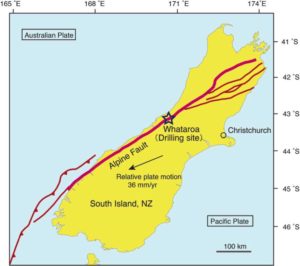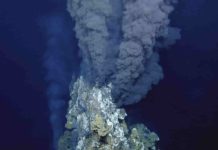
A recent study published in Nature has demonstrated unusual heat generation and fluid movement in the Alpine Fault of New Zealand that has implications for understanding earthquakes in the region. Large plate-boundary faults, such as the Alpine Fault, are important areas of stress build-up and release, which can lead to earthquakes. There is increasing evidence that faults in such regions have lower than predicted frictional shear strength, and are subject to very limited heat generation during fault slippage.
The Deep Fault Drilling Project (DFDP) investigates fault strength and heat generation in the Alpine Fault. Naoki Kato of the Department of Earth and Space Science, Osaka University, who co-authored the work, says, “The primary motivation of the DFDP was to provide an understanding of the ambient conditions, rock properties and geophysical phenomena that occur immediately before a large earthquake, because we just don’t know enough about active faults before they rupture.”
The research team drilled to a depth of 893 m directly into the active Alpine Fault in Whataroa, New Zealand. The fault moves at about 26 mm per year, and has, over time, brought rocks to the near-surface from depths of 30 km. The researchers used various geophysical techniques and tools, including fiber optics, to obtain very precise temperature measurements. They revealed a pressure gradient almost 10 percent greater than expected, and temperature gradients (>80 °C.km-1) more typical of active volcanic regions.
The temperature structure of the fault was modeled in terms of heat conduction, rock advection and fluid advection related to topography. “Our models show that rock advection and thermal diffusion are the primary heat transport mechanisms in the principal slip zone, and it is fault slip itself that brings both rock and heat up from depth” Naoki Kato says. The models and drilling data both show that lateral fluid movement transports significant amounts of heat and fluids from depth, both of which concentrate into valleys.
Heat generation and fluid migration is important in active faults because both directly affect the stability of phyllosilicate minerals (clays), thermal rock expansion and the formation of physical and chemical reaction products in the fault slip zone. These in turn control the frictional and mechanical behavior of faults, and therefore the behavior of earthquakes that may occur during slippage. This study sheds new light on earthquake development in active fault regions because shallow temperature and hydrothermal anomalies, and their lateral variation, affect dynamic strength along the length of the fault.
Reference:
Rupert Sutherland et al, Extreme hydrothermal conditions at an active plate-bounding fault, Nature (2017). DOI: 10.1038/nature22355
Note: The above post is reprinted from materials provided by Osaka University.










